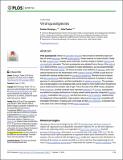Por favor, use este identificador para citar o enlazar a este item:
http://hdl.handle.net/10261/216420COMPARTIR / EXPORTAR:
 SHARE SHARE
 CORE
BASE CORE
BASE
|
|
| Visualizar otros formatos: MARC | Dublin Core | RDF | ORE | MODS | METS | DIDL | DATACITE | |

| Campo DC | Valor | Lengua/Idioma |
|---|---|---|
| dc.contributor.author | Domingo, Esteban | - |
| dc.contributor.author | Perales, Celia | - |
| dc.date.accessioned | 2020-07-10T09:40:43Z | - |
| dc.date.available | 2020-07-10T09:40:43Z | - |
| dc.date.issued | 2019-10-17 | - |
| dc.identifier | doi: 10.1371/journal.pgen.1008271 | - |
| dc.identifier | issn: 1553-7404 | - |
| dc.identifier.citation | PLoS Genetics 15 (2019) | - |
| dc.identifier.uri | http://hdl.handle.net/10261/216420 | - |
| dc.description.abstract | Viral quasispecies refers to a population structure that consists of extremely large numbers of variant genomes, termed mutant spectra, mutant swarms or mutant clouds. Fueled by high mutation rates, mutants arise continually, and they change in relative frequency as viral replication proceeds. The term quasispecies was adopted from a theory of the origin of life in which primitive replicons) consisted of mutant distributions, as found experimentally with present day RNA viruses. The theory provided a new definition of wild type, and a onceptual framework for the interpretation of the adaptive potential of RNA viruses that contrasted with classical studies based on consensus sequences. Standard clonal analyses and deep sequencing methodologies have confirmed the presence of myriads of mutant genomes in viral populations, and their participation in adaptive processes. The quasispecies concept applies to any biological entity, but its impact is more evident when the genome ize is limited and the mutation rate is high. This is the case of the RNA viruses, ubiquitous in our biosphere, and that comprise many important pathogens. In virology, quasispecies are defined as complex distributions of closely related variant genomes subjected to genetic variation, competition and selection, and that may act as a unit of selection. Despite being an integral part of their replication, high mutation rates have an upper limit compatible with inheritable information. Crossing such a limit leads to RNA virus extinction, a transition that is the basis of an antiviral design termed lethal mutagenesis | - |
| dc.description.sponsorship | BFU2011-23604, SAF2014-52400-R, SAF2017-87846-R and BFU2017-91384-EXP, from the Spanish Ministerio de Economía y Competitividad (MINECO and S2013/ABI-2906 (PLATESA from Comunidad de Madrid/FEDER). CIBERehd (Centro de Investigacio´n en Red de Enfermedades Hepáticas y Digestivas)is funded by Instituto de Salud Carlos III. C.P. is supported by the Miguel Servet program of the Instituto de Salud Carlos III (CP14/00121) cofinanced by the European Regional Development Fund (ERDF). Institutional grants from the Fundación Ramón Areces and Banco Santander | - |
| dc.language | eng | - |
| dc.publisher | Public Library of Science | - |
| dc.relation.isversionof | Publisher's version | - |
| dc.rights | openAccess | - |
| dc.title | Viral quasispecies | - |
| dc.type | artículo | - |
| dc.identifier.doi | 10.1371/journal.pgen.1008271 | - |
| dc.relation.publisherversion | http://dx.doi.org/10.1371/journal.pgen.1008271 | - |
| dc.date.updated | 2020-07-10T09:40:43Z | - |
| dc.rights.license | https://creativecommons.org/licenses/by/4.0/ | - |
| dc.contributor.funder | Ministerio de Economía y Competitividad (España) | - |
| dc.contributor.funder | Centro de Investigación Biomédica en Red Enfermedades Hepáticas y Digestivas (España) | - |
| dc.contributor.funder | Instituto de Salud Carlos III | - |
| dc.contributor.funder | European Commission | - |
| dc.contributor.funder | Fundación Ramón Areces | - |
| dc.contributor.funder | Banco Santander | - |
| dc.relation.csic | Sí | - |
| dc.identifier.funder | http://dx.doi.org/10.13039/501100004587 | es_ES |
| dc.identifier.funder | http://dx.doi.org/10.13039/100010784 | es_ES |
| dc.identifier.funder | http://dx.doi.org/10.13039/501100000780 | es_ES |
| dc.identifier.funder | http://dx.doi.org/10.13039/100008054 | es_ES |
| dc.identifier.funder | http://dx.doi.org/10.13039/501100003329 | es_ES |
| dc.identifier.pmid | 31622336 | - |
| dc.type.coar | http://purl.org/coar/resource_type/c_6501 | es_ES |
| item.openairetype | artículo | - |
| item.grantfulltext | open | - |
| item.cerifentitytype | Publications | - |
| item.openairecristype | http://purl.org/coar/resource_type/c_18cf | - |
| item.fulltext | With Fulltext | - |
| Aparece en las colecciones: | (CBM) Artículos | |
Ficheros en este ítem:
| Fichero | Descripción | Tamaño | Formato | |
|---|---|---|---|---|
| PeralesC_ViralQuasispecies.pdf | 1,89 MB | Adobe PDF |  Visualizar/Abrir |
CORE Recommender
PubMed Central
Citations
136
checked on 19-abr-2024
SCOPUSTM
Citations
179
checked on 17-abr-2024
WEB OF SCIENCETM
Citations
167
checked on 23-feb-2024
Page view(s)
123
checked on 18-abr-2024
Download(s)
49
checked on 18-abr-2024

